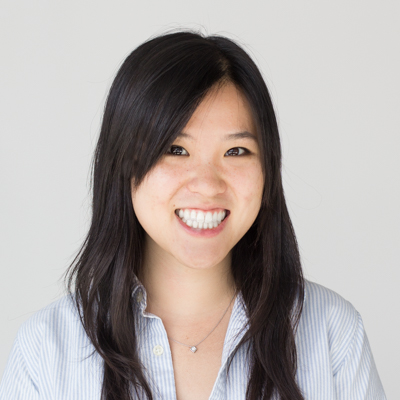Digital health funding 2015 midyear review
Coming off a record-smashing year for digital health funding, where dollars into the space totaled more than 8% of all venture funding, it would not have been surprising if 2015 was a let down. However, 2015 has more or less kept pace with 2014. Digital health funding continues to grow faster than venture funding overall, suggesting a growing importance in every venture capitalist’s portfolio.
Alongside the growth has come a downside—noise. With 136 companies raising more than $2M in just the first half of 2015, including 80 companies raising their first significant capital, there has never been this many digital health companies vying for the attention of both the industry and the consumer.
As we wrote in our last report on funding, it is time for name-brand digital health companies to start exiting and returning capital to investors. 2015 has not disappointed, with five IPOs creating $11B in market capitalization, including the unquestioned winner of the first half, Fitbit.
The last half of the year can turn many ways—there will definitely be more IPOs, and with venture markets extraordinarily hot, there will be a few important rounds coming this summer.
Dollars and deals
Venture funding of digital health companies in 2015 is closely mirroring 2014’s record-breaking year, with funding surpassing $2B through the first half.
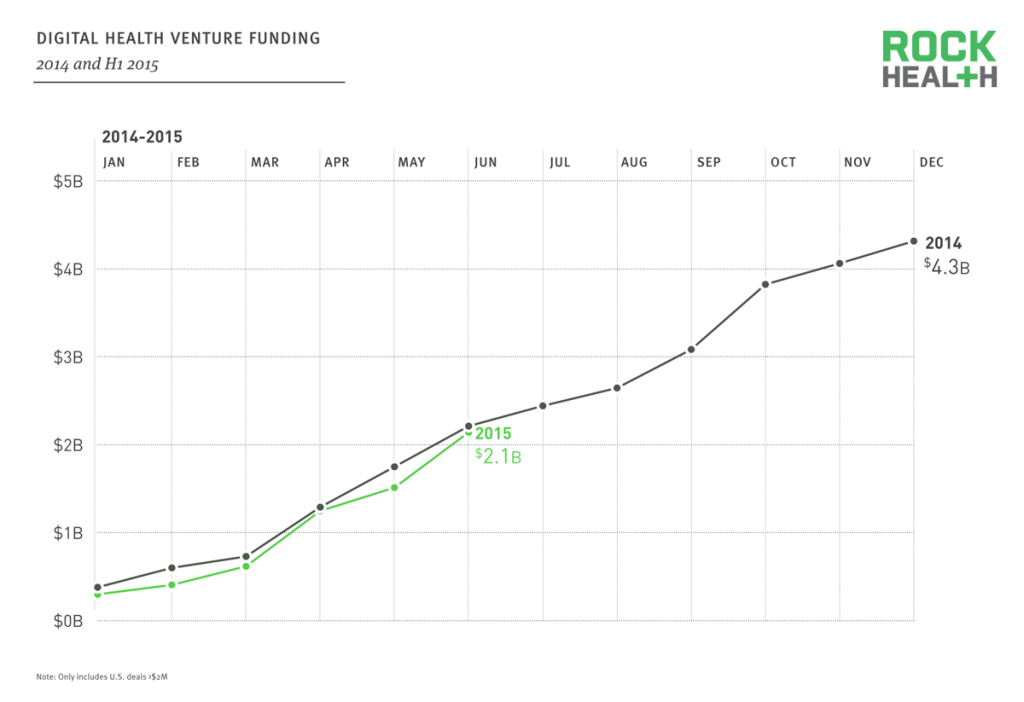
Source: Rock Health Funding Database
Following significant growth in digital health funding last year, the pace has been slightly slower to start 2015, coming in about $70M short of 2014’s first half record. Growth on a trailing twelve month (TTM) basis continues, with funding up 25% over that timeframe.
While the first quarter had few large rounds (average deal size was $10M in Q1), the second quarter brought a number of large deals, pushing the 2015 average deal size above $15M, exceeding 2014’s $14.6M.
Digital health funding continues to grow faster than overall venture funding and funding in the software, biotech, and medical device sectors.
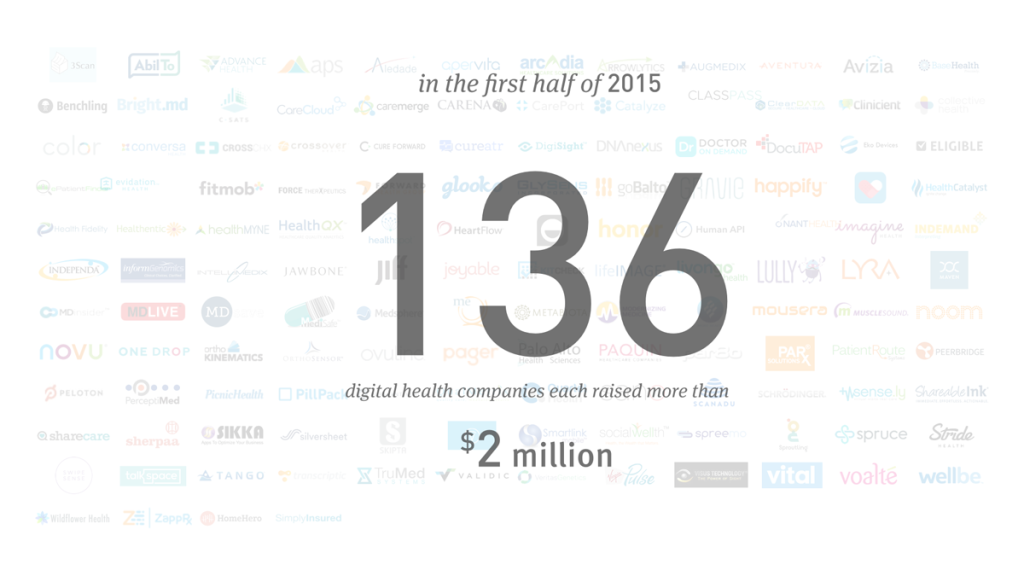
The six largest rounds of the year represent over one third of all funding in 2015.

Source: Rock Health Funding Database
The three largest venture deals of the year, all growth capital, could not present more diverse companies. On the one end, Virgin Pulse is taking its first outside capital, having been funded by the Virgin Group since its inception 12 years ago.
On the other end, Jawbone and NantHealth combined have taken on at least $1.3B in venture capital. These latest rounds, financed by BlackRock (Jawbone) and Allscripts (NantHealth) show the diverse base of investors that later stage companies are pulling from in advance of hopeful public offerings.
Doctor on Demand raised one of the largest Series B rounds in the history of digital health, only exceeded by NantHealth, Evolent Health, and Flatiron Health’s rounds.
The top six categories accounted for more than 50% of all digital health funding in 2015, three of which were not ranked within the top six in 2014.
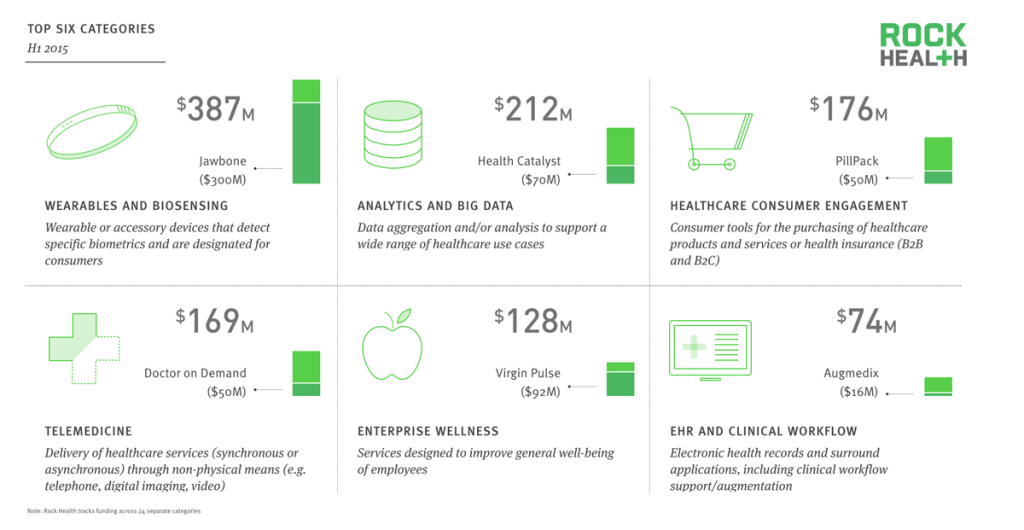
Source: Rock Health Funding Database
Investors
There was a slight increase in the number of Series B stage deals; however, Seed and Series A stage deals continue to drive the vast majority of deal volume.
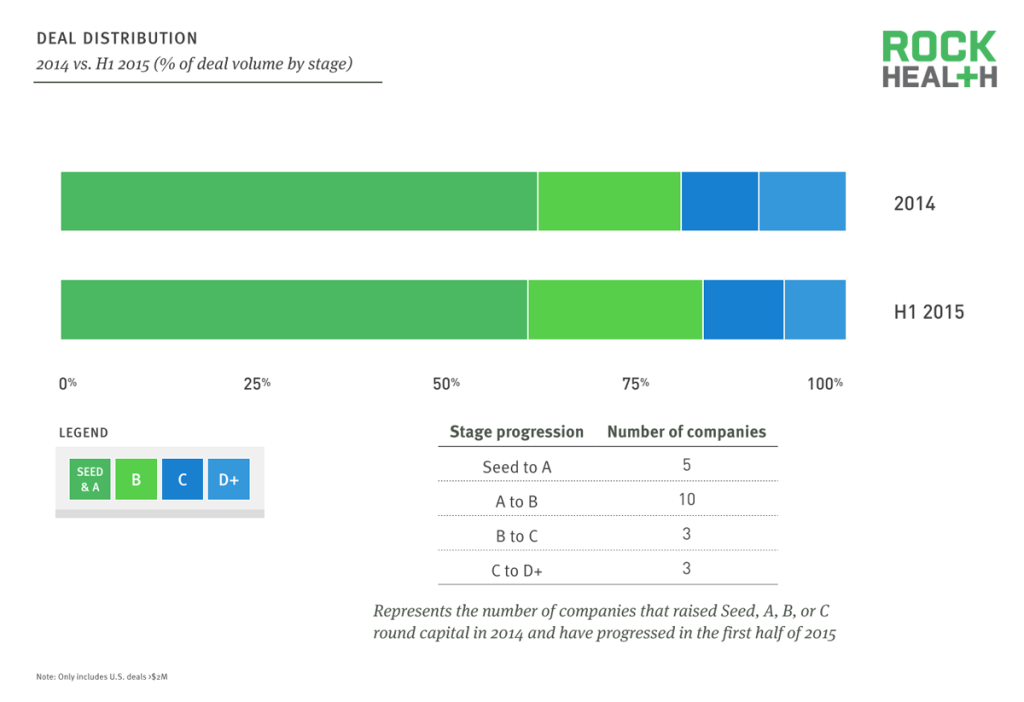
Source: Rock Health Funding Database
In the first half of 2015, Series B represented 22% of overall deal volume versus only 18% in 2014, with ten companies who raised Series A in 2014 progressing “on time” into their Series B raises.
Stride Health and PillPack were notable for announcing round-to-round progress (Seed to A, and Series B to Series C, respectively) in under 12 months.
Average deal size by round has remained consistent at the early stage, while round sizes were down 20-25% in Series C and Series B (H1 2015 versus 2014), respectively.
Venture funds continue to be active in early stage deals while corporate venture funds invested heavily in later stage deals.

Source: Rock Health Funding Database
Many of the most active venture investors return in 2015, including NEA, Venrock, First Round, and Social+Capital Partnership. They were joined by new names, including RRE Ventures and Thrive Capital.
The top of the corporate investor ranks has remained largely the same, with Google Ventures falling off the most active list as they move towards broader life sciences initiatives.
We tracked 330 distinct investors to date in 2015, with nearly a third of those doing their first and only digital health deal since 2011.
Geographies
Most digital health companies continue to be funded in California, with Bay Area-based companies accounting for just over half of all 2015 funding.
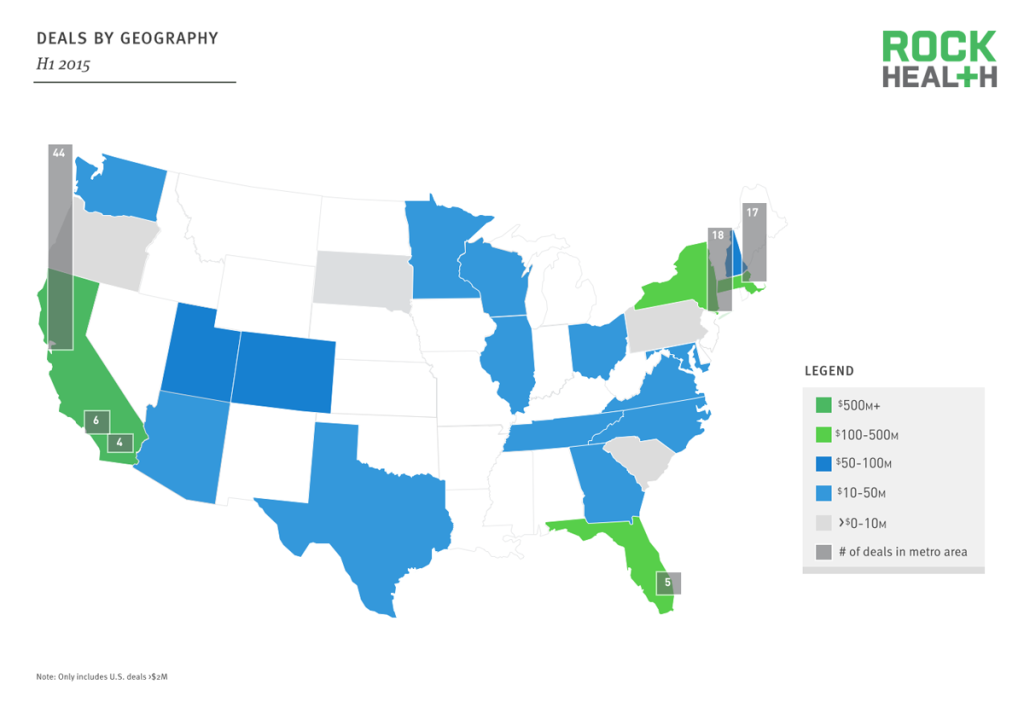
Source: Rock Health Funding Database
Digital health companies from 23 states received funding (in five years of tracking, nine states have no recorded digital health deals) with California accounting for 51% of all dollars (Jawbone and NantHealth alone accounted for nearly 25% of all dollars).
Boston and New York City continue to tussle for the second largest digital health hub in the U.S., with New York City doing one additional deal but each accounting for 11% of the total venture dollars.
Exits and public markets
Only halfway through 2015, there have already been 92 M&A deals, which is almost as many as all of 2014, but total disclosed dollars only reached $2.6B.
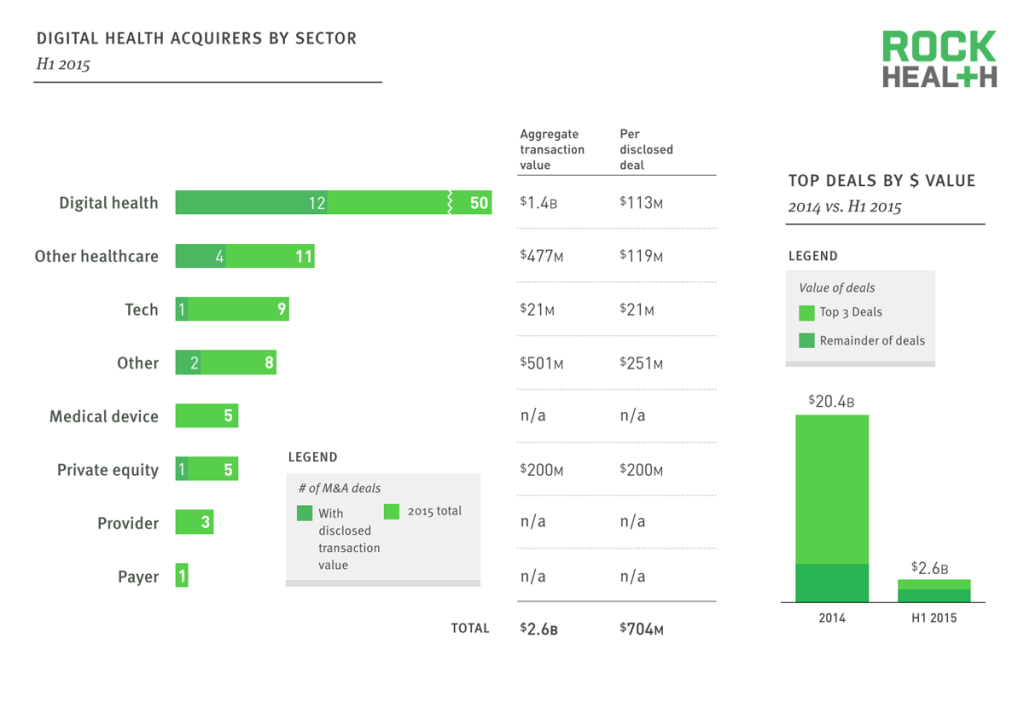
Source: Rock Health tracking and analysis based on news reports and company filings
In 2014, we tracked a total of 95 digital health company acquisitions, while only halfway through 2015 we have already tracked 92 digital health deals. Other digital health companies continue to be the most active acquirers, acquiring more than half of the companies tracked.
The most notable transactions in 2015 include the Under Armour purchase of MyFitnessPal for $475M and Managed Health Care Associates purchasing LTC pharmacy software company SoftWriters for $450M.
Four venture-backed digital health companies have gone public in the first half of the year, and Teladoc debuted on day one of the second half of 2015.
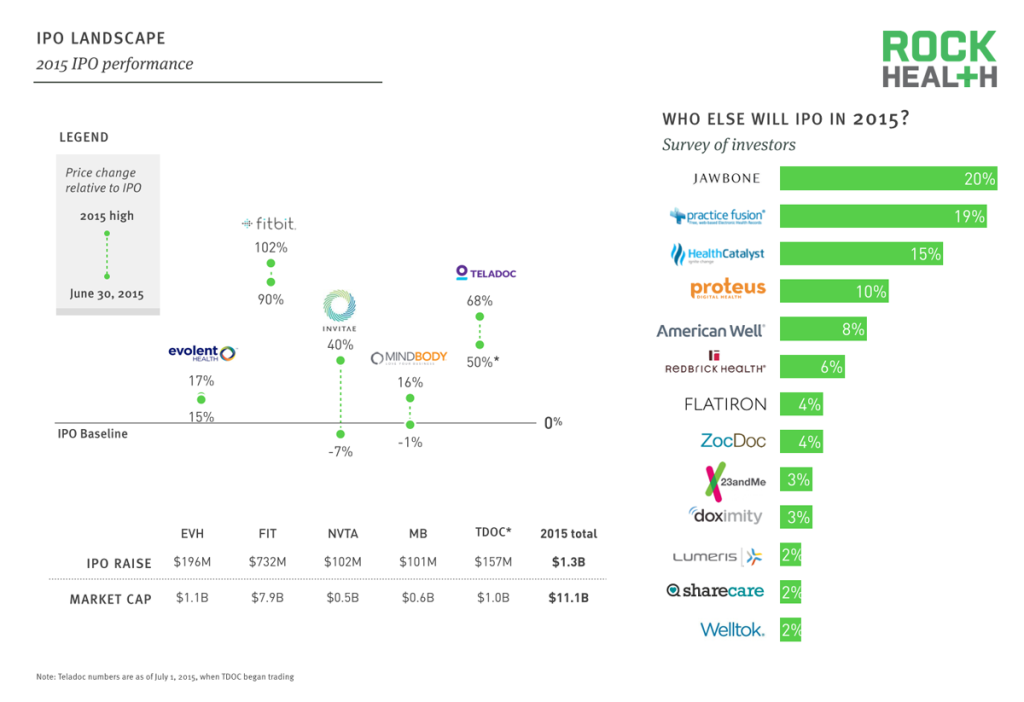
Source: 2015 performance from NASDAQ as of market close on June 30, 2015; investor survey was conducted on May 30, 2015 at the Fenwick Investor Summit (n = 39)
Venture-backed digital health companies with IPOs in the first half of 2015 were able to raise more than $1B in overall capital and reached more than $10B in total market capitalization.
The Fitbit IPO was the largest technology IPO of the year (all sectors) and had an incredibly successful debut, while both Evolent and Teladoc were able to move above $1B market caps post-offering.
While mirroring general market trends, publicly-traded digital health companies were able to outperform the broader S&P 500 public market index in the first half of 2015.
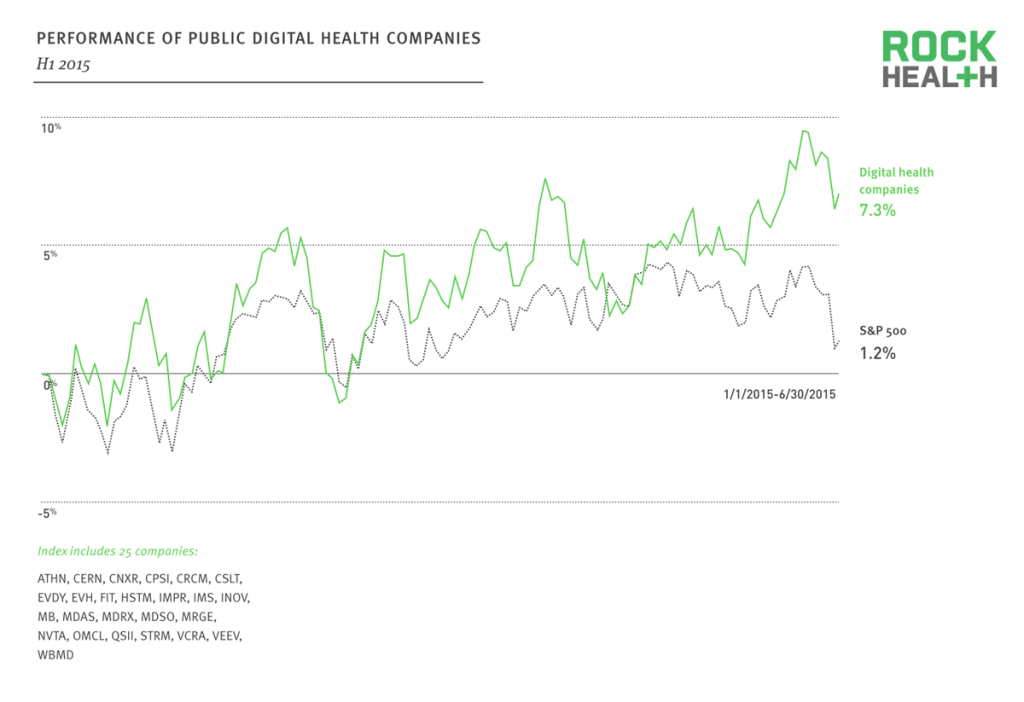
Source: The Digital Health Public Company Index by Rock Health (as of market close on June 30, 2015); Available from Motif Investing.
The digital health public company index is comprised of 25 companies, totaling $71B in aggregate value (Cerner, IMS, and Fitbit hold nearly 60% of the value). The digital health index was able to significantly outperform the broader stock market through the first half in 2015, and was assisted by the addition of Fitbit in June.
Summary of findings
Funding and deal volume: Venture funding for digital health companies in the first half of 2015 reached $2.1B, closely mirroring total funding in 2014. This represents 25% TTM (Q3 2014-Q2 2015) growth in funding compared to Q3 2013-Q2 2014. 139 deals, across 136 companies, closed with an average deal size of $15.4M.
Major themes: The top six themes of the year that received 54% of all funding included: wearables and biosensing, analytics and big data, healthcare consumer engagement, telemedicine, enterprise wellness, and EHR and clinical workflow. Analytics and big data, in addition to healthcare consumer engagement continue to be the categories which appear in the top six year after year.
Most active funds: In 2015, 330 distinct investors funded digital health companies, 108 investors that funded a digital health company for the first time. The most active corporate digital health investors have remained stable—and diverse—over the past four years.
Exit activity: There was a lot of M&A activity in the first half of 2015. There were 92 M&A transactions tracked, closing in rapidly on the 95 deals done in 2014. However, disclosed deal value was significantly lower than last year ($20.4B in 2014 vs $2.6B in H1 2015). Digital health companies were still the most active acquirers of other digital health companies. Beyond private exits, the public markets welcomed five venture-backed digital health companies (Teladoc debuted on July 1st) with a total current market capitalization of $11B.
Methodologies
What is digital health?
Rock Health defines digital health as the intersection of healthcare and technology. This means that the venture funding tracked only includes technology-enabled health-related companies, whether they focus on the administration of healthcare, the delivery of healthcare, or the process of bringing breakthrough new healthcare products to market (both R&D and commercialization).
Healthcare companies that aren’t digital. Health insurance companies, such as Oscar, or healthcare providers, such as One Medical, are pure services companies (that employ technology, certainly, as does every company). This is in direct contrast to a technology-enabled services business such as telemedicine, that simply could not exist without digital. Molecular diagnostic companies, such as Guardant Health, that perform testing and render a definitive diagnosis to physicians are also excluded. Similar to biopharma companies, molecular diagnostic companies are significantly more capital intensive than software-based companies and would skew funding.
Technology companies that aren’t healthcare. Companies diversified across industries are not included. Software companies focused across human resources (and not solely health benefits), such as Zenefits, are not included.
How we track digital health funding
Rock Health funding data only includes disclosed US deals over $2M. Deals under $2M would be impossible to track comprehensively since companies often do not file their small seed rounds with the SEC or disclose to press. We also believe that deals under $2M generate noise in key statistics, including deal count and average deal size. Disclosed deals under $2M represent less than 5% of the total we report, giving us confidence in our overall figures.
In prior years, we have attempted to include international companies that were funded by U.S. investors, monitoring the portfolios of hundreds of VCs. In reviewing this data, we have concluded that it is challenging to track all international deals and beginning with this 2014 year end report, we are no longer tracking or reporting any international deals. All numbers in this report are for U.S.-based companies only.
Funding tracked includes debt, venture rounds, and growth equity but excludes lines of credit (working capital) and cash/equity associated with merger or acquisition activities.
Deals data is gathered based on publicly available resources (press releases, news outlets, SEC filings, etc.) and supplemented with CapIQ’s venture data.

